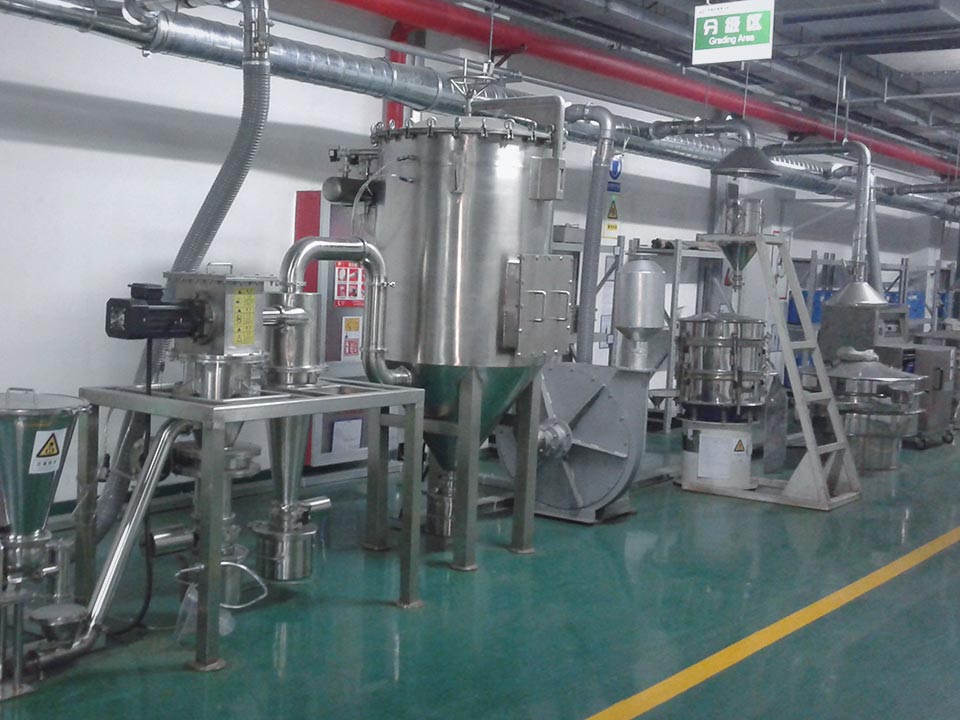The air classifier can accurately classify metal powder
The rapid development of 3D printing has been widely used in our real life. The production of metal powder is a very critical part, but it is often overlooked. For high-quality special metals with superior mechanical properties required in the industry, alloy metal powders are showing an increasing trend. Airflow classifier is a common equipment in metal powder processing, and it is also a more important equipment. Only qualified finished metal powders screened by the airflow classifier can be put into application.

The metal powder air classifier is a classifying system composed of a classifier, a dust collector, and an induced draft fan. Under the action of fan suction, the material moves at high speed from the lower end of the classifier to the classification area with the updraft. Under the action of the strong centrifugal force generated by the high-speed rotating classification vortex, the coarse and fine materials are separated, and the fine particles that meet the particle size requirements are classified. The gap between the wheel blades enters the cyclone separator or the dust collector to collect, the coarse particles entrained by the part of the fine particles hit the wall and the speed disappears, and they descend along the cylinder wall to the secondary air outlet. After the strong elutriation of the secondary air, the coarse and fine particles are separated. The particles rise to the classification zone for secondary classification, and the coarse particles fall to the discharge port for discharge.
Equipment performance characteristics of metal powder air classifier:
1. It does not need to be washed with water or water, and it is produced by completely dry method, which can obtain a narrower particle size distribution and non-polluting abrasive powder; one grade can be processed into products of any brand according to the current domestic and foreign standards (such as: national standard W63~W3.5, Japanese standard 240#~3000# and European standard F230/53~F1200/3). The single number finished product rate reaches more than 75%.
2. The classification accuracy is high, the cutting particle size is more accurate, the required speed is lower, and the service life is long.
3. Independent casting bearing seat, never deformed, and long service life.
4. Optimized transmission design, small bearing force and long service life.
5. Unique piping design helps powder flow, helps reduce abrasion, and easy-to-wear parts are easy to replace and handle.
6. The unique frequency conversion feeding system is helpful for the dispersion of materials, can ensure the continuous uniformity and stability of the feeding, and is helpful for the control of product particle size.
7. Unique internal circulation secondary air design, adjustable grading cone gap, greatly reduced air consumption, lower grading energy consumption, and thorough extraction of fine powder.
8. The separation of the flow path helps to slow down the abrasion at the bottom of the classification wheel and is more conducive to the control of large particles.
9. Fully enclosed negative pressure operation, no dust pollution.
10. Good stability, stable production after adjusting the fixed parameters once;
11. In particular, the core competitive advantage of more thorough extraction of fine powder and good stability has been widely recognized by the industry.
12. The whole system adopts automatic control, which can realize one-button start and stop, and the operation is simple and convenient. The connection with the central control can realize remote control.
- General application:
It can classify materials that cannot be classified on ordinary sorting equipment. It is especially suitable for processing products that strictly limit the largest particle size and require a narrow particle size distribution, such as heavy calcium, kaolin, talcum powder, barite powder, copier toner, paint, Mica, graphite, auxin, aluminum hydroxide, etc.
- High-purity applications:
It can classify materials with extremely strict impurity content or materials that are extremely sensitive to iron, while meeting the requirements of particle size and particle size distribution. Typical materials are: fluorescent powder, titanium dioxide, starch, silica gel, aluminum, copper, luminescent powder and various high-purity pigments.
- Abrasive and hard materials:
The application of the vertical eddy current classifier can exceed the subdivision level of hard materials with a Mohs hardness level of seven or more, so that the wear of the equipment is extremely small. The rotating speed of the grading wheel can be adjusted, and the crushing parameters can be optimized. The combination of multiple classifiers can complete narrow-band classification of several particle sizes at one time. Typical products are: diamond, silicon carbide, boron carbide, tungsten carbide, special ceramics, emery and so on.
- Food, health products, medicine:
It can superfinely process the raw materials of medicine, food and health care products. Its low-temperature pulverization, high-purity operation, high processing finish and easy cleaning of the machine are ideal for use in the pharmaceutical, health care and food industries, which not only improves the bioavailability of medicines. And curative effect, and reduce production cost. Typical products are: pollen, hawthorn, shiitake mushroom, pearl powder, stomach medicine, nimodipine, antibiotic medicine, contrast medicine, Ganoderma lucidum, gallnut, fleece-flower root, etc.
